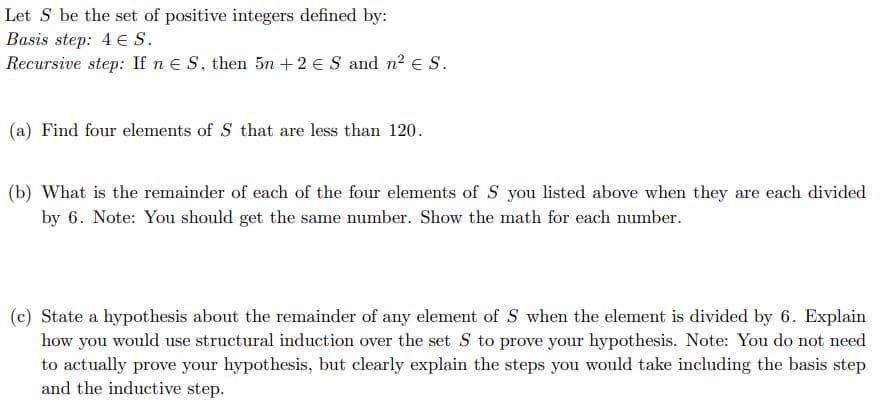Let S be the set of positive integers defined by: Basis step: 4 € S. Recursive step: If n e S, then 5n +2 € S and n? e S. (a) Find four elements of S that are less than 120. (b) What is the remainder of each of the four elements of S you listed above when they are each divided by 6. Note: You should get the same number. Show the math for each number. (c) State a hypothesis about the remainder of any element of S when the element is divided by 6. Explain how you would use structural induction over the set S to prove your hypothesis. Note: You do not need to actually prove your hypothesis, but clearly explain the steps you would take including the basis step and the inductive sten
Let S be the set of positive integers defined by: Basis step: 4 € S. Recursive step: If n e S, then 5n +2 € S and n? e S. (a) Find four elements of S that are less than 120. (b) What is the remainder of each of the four elements of S you listed above when they are each divided by 6. Note: You should get the same number. Show the math for each number. (c) State a hypothesis about the remainder of any element of S when the element is divided by 6. Explain how you would use structural induction over the set S to prove your hypothesis. Note: You do not need to actually prove your hypothesis, but clearly explain the steps you would take including the basis step and the inductive sten
Computer Networking: A Top-Down Approach (7th Edition)
7th Edition
ISBN:9780133594140
Author:James Kurose, Keith Ross
Publisher:James Kurose, Keith Ross
Chapter1: Computer Networks And The Internet
Section: Chapter Questions
Problem R1RQ: What is the difference between a host and an end system? List several different types of end...
Related questions
Question

Transcribed Image Text:Let S be the set of positive integers defined by:
Basis step: 4 € S.
Recursive step: If nE S, then 5n +2 e S and n? e S.
(a) Find four elements of S that are less than 120.
(b) What is the remainder of each of the four elements of S you listed above when they are each divided
by 6. Note: You should get the same number. Show the math for each number.
(c) State a hypothesis about the remainder of any element of S when the element is divided by 6. Explain
how you would use structural induction over the set S to prove your hypothesis. Note: You do not need
to actually prove your hypothesis, but clearly explain the steps you would take including the basis step
and the inductive step.
Expert Solution
This question has been solved!
Explore an expertly crafted, step-by-step solution for a thorough understanding of key concepts.
This is a popular solution!
Trending now
This is a popular solution!
Step by step
Solved in 2 steps

Recommended textbooks for you

Computer Networking: A Top-Down Approach (7th Edi…
Computer Engineering
ISBN:
9780133594140
Author:
James Kurose, Keith Ross
Publisher:
PEARSON

Computer Organization and Design MIPS Edition, Fi…
Computer Engineering
ISBN:
9780124077263
Author:
David A. Patterson, John L. Hennessy
Publisher:
Elsevier Science

Network+ Guide to Networks (MindTap Course List)
Computer Engineering
ISBN:
9781337569330
Author:
Jill West, Tamara Dean, Jean Andrews
Publisher:
Cengage Learning

Computer Networking: A Top-Down Approach (7th Edi…
Computer Engineering
ISBN:
9780133594140
Author:
James Kurose, Keith Ross
Publisher:
PEARSON

Computer Organization and Design MIPS Edition, Fi…
Computer Engineering
ISBN:
9780124077263
Author:
David A. Patterson, John L. Hennessy
Publisher:
Elsevier Science

Network+ Guide to Networks (MindTap Course List)
Computer Engineering
ISBN:
9781337569330
Author:
Jill West, Tamara Dean, Jean Andrews
Publisher:
Cengage Learning

Concepts of Database Management
Computer Engineering
ISBN:
9781337093422
Author:
Joy L. Starks, Philip J. Pratt, Mary Z. Last
Publisher:
Cengage Learning

Prelude to Programming
Computer Engineering
ISBN:
9780133750423
Author:
VENIT, Stewart
Publisher:
Pearson Education

Sc Business Data Communications and Networking, T…
Computer Engineering
ISBN:
9781119368830
Author:
FITZGERALD
Publisher:
WILEY